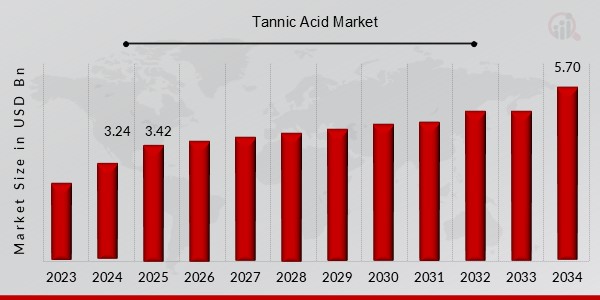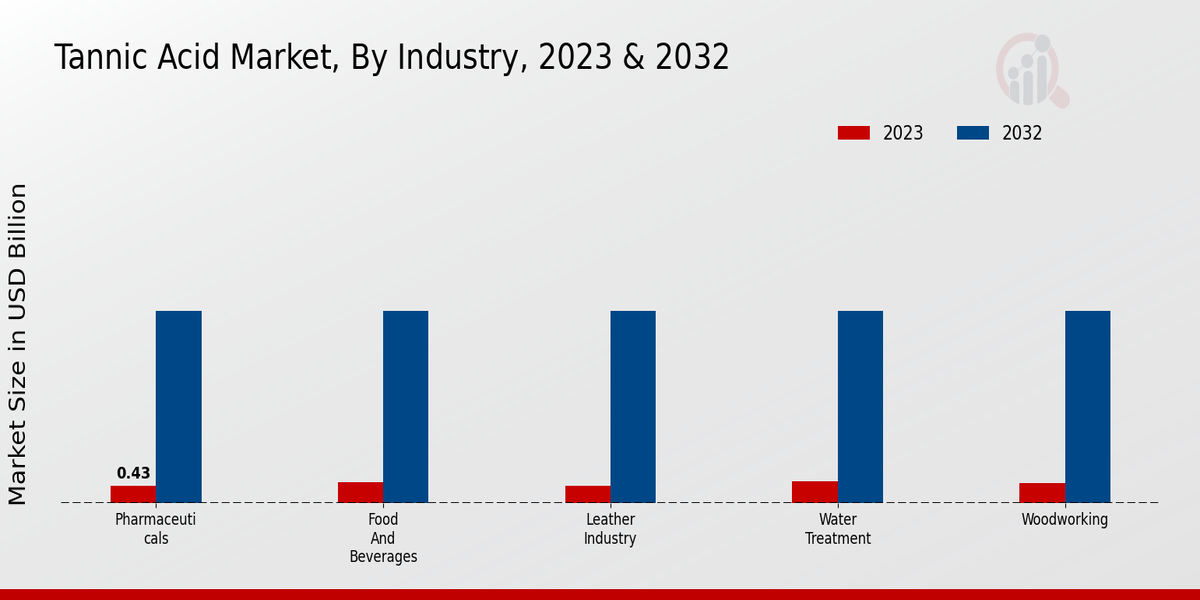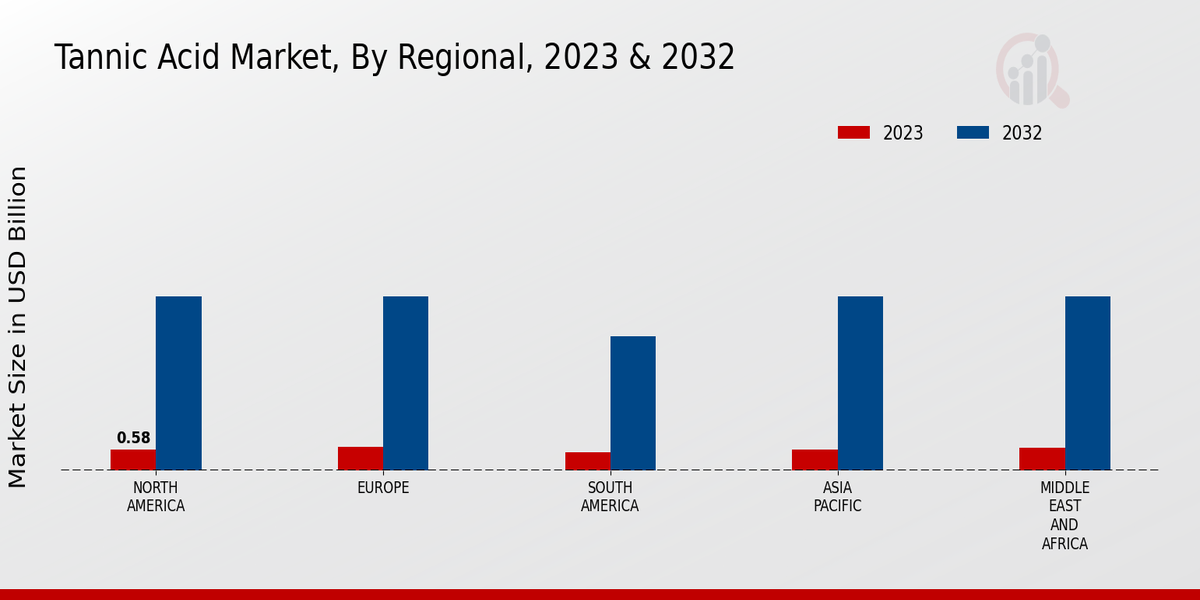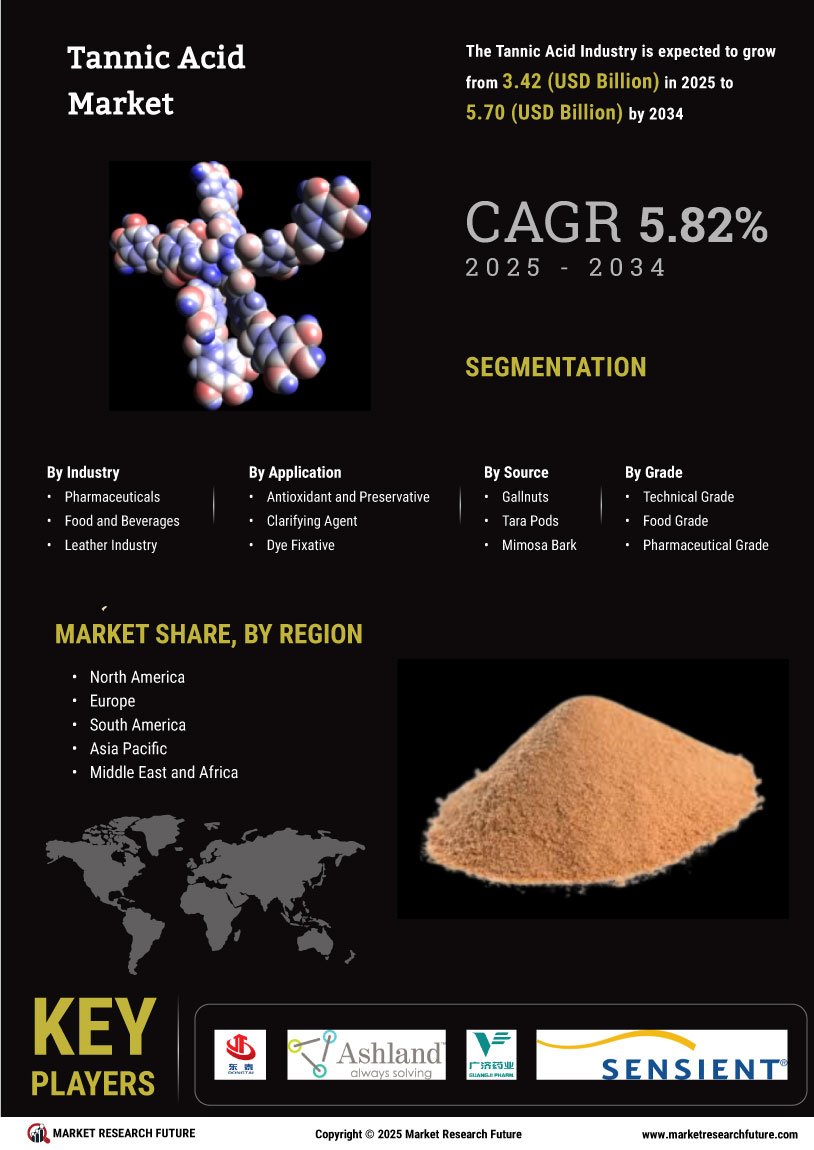Global Tannic Acid Market Overview
The Tannic Acid Market Size was estimated at 3.24 (USD Billion) in 2024. The Tannic Acid Industry is expected to grow from 3.42 (USD Billion) in 2025 to 5.70 (USD Billion) by 2034. The Tannic Acid Market CAGR (growth rate) is expected to be around 5.82% during the forecast period (2025 - 2034).
Key Tannic Acid Market Trends Highlighted
The tannic acid market exhibits notable growth, primarily driven by its widespread applications in various industries. Medical and pharmaceutical applications, such as wound healing and drug delivery systems, have emerged as significant market drivers. The food and beverage sector also contributes to market growth, with tannic acid utilized as a food additive and flavoring agent. Additionally, the leather industry leverages tannic acid for leather tanning and finishing processes, enhancing its strength and durability. Opportunities for market expansion lie in exploring sustainable sources of tannic acid and developing innovative applications in emerging industries, such as cosmetics and personal care. Recent market trends indicate a shift towards natural and eco-friendly products, increasing the demand for tannic acid derived from plant-based sources. Technological advancements in extraction and purification methods are also driving market growth by improving the efficiency and cost-effectiveness of tannic acid production.

Source: Primary Research, Secondary Research, MRFR Database and Analyst Review
Tannic Acid Market Drivers
- Rising Demand from the Food and Beverage Industry
Tannic acid is widely used in the food and beverage industry, specifically as a flavoring agent and preservative. The market is expected to expand for tannic acid products, as they are widely used in the production of various food and beverage products, such as fruit juices, wine, beer, and soft drinks. Another factor that can contribute to market growth is that the same acid is used in the production of drinks such as tea and coffee, which are some of the most popular beverages consumed all over the world, as well as the increasing preference for functional beverages on the market and the fact that organic and environmentally friendly food ingredients are becoming increasingly popular.
Expanding Pharmaceutical and Cosmetic Applications
Tannic acid has become an important compound in the production of pharmaceutical and cosmetic products due to a certain set of unique properties. As for the pharmaceutical industry, tannic acid is used as an astringent and antiseptic in the production of different topical medicines: ointments, creams, lotions and so on. In addition, it is widely used in the treatment of burn wounds, sores or any local skin infections. Tannic aid is also researched for new drug production, in particular in the sphere of anti-inflammatory and antimicrobial therapy groups.As for the cosmetic industry, tannic acid is largely used as an antioxidant which qualities can help to diminish skin aging. The idea of a natural antioxidative compound that is able to successfully fight off free radicals, thus preventing premature skin aging, was actualized in creams, masks and serums.
Growth in Leather Tanning and Textile Industries
Industry i: History Tannic acid was used many years ago in leather tanning, and it is a natural tanning agent that gives the leather a unique brown color. High-quality leather goods such as handbags, shoes, and upholstery are made using leather that is tanned by tannic acid. Industry ii: Demand The demand for tannic acid for the production of leather has led to the growth of the tannic acid market in the leather tanning industry in recent years.Tannic acid is used in the textile industry as a mordant, a substance that helps in fixing dyes on fabrics. The growing demand for natural and sustainable ways of dyeing textiles will provide an opportunity for the use of tannic acid in the textile industry.
Tannic Acid Market Segment Insights
Tannic Acid Market Industry Insights
The tannic acid market is divided into several industries, including pharmaceuticals, food and beverages, the leather industry, water treatment, woodworking, and textile dyeing, each of which has its unique requirements and tannic applications. In the pharmaceutical industry, it is used in the production of many medicinal drugs, such as astringents, antidiarrheals, and agents for wound healing, among others. Its hemostatic properties help stop the bleeding and treat wounds. Therefore, the increased application of tannic acid in the development of various drugs will have a positive influence on the market growth during the forecast period.As for the food and beverage sector, it is another significant consumer of tannic acid. It is used as a clarifying agent in the industrial production of wines, beer, and fruit juices. Since tannic acid helps get rid of the impurities that spoil the drinks, they become tastier and nicer in color. Moreover, given the growing popularity of craft beers and wines among consumers, this sector is also expected to drive the growth of the tannic acid market in the coming years. The leather industry and manufacturing of different leather goods are widely dependent on tannic acid, as it is used as a tanning agent.By reacting with animal collagen fibers, tannic acid is able to produce durable and flexible leather. The rising demand for leather goods, especially in developing countries, will also drive the target market growth in the given sector. Tannic acid is also used for the purification of water, which serves as another application. It acts as a coagulant and flocculant by getting rid of suspended solids and other impurities. Today, the demand for clean water is growing, and many countries are looking for solutions to their water problems, which means that the market growth for tannic acid used in water treatment is facilitated.In the woodworking sector, tannic acid serves as a high-quality mordant and wood stain. When mixed with wood, it helps define the wood patterns and color thanks to tannins in the wood. In addition, the target market applications include the development of wood adhesives, which guarantee long-lasting bonding. Finally, the textile dyeing sector that is trying to substitute the synthetic dyes with eco-friendly ones also utilizes tannic acid as a mordant that fixes the dyes to the fabric as it creates complexes with the tannin dye that “increased the relative molecular mass and ensures the dye components adhere to the fiber”.
Source: Primary Research, Secondary Research, MRFR Database and Analyst Review
Tannic Acid Market Application Insights
The Tannic Acid Market is segmented on the basis of application. Application segment analysis for the tannic acid market includes antioxidants and preservatives, clarifying agents, dye fixatives, tannin analyzers, antiseptic and astringents, wood treatment, and others. Among these, the antioxidant and preservative segment accounted for the largest market for tannic acid in 2023 and is projected to continue dominating during the forecast period. The demand for natural preservatives and antioxidants in the food and beverage industry is growing the market of this segment.The clarifying agent segment is projected to witness the highest CAGR throughout the forecast period. The use of tannic acid in the beverage industry to clarify and stabilize beverages is the principal factor driving this segment. The dye fixative segment is expected to maintain steady growth, led by the demand for natural dyes in the textile industry. The antiseptic and astringent segment is expected to grow at a gradual pace by growing its use of tannic acid in personal care and pharmaceuticals.
Tannic Acid Market Source Insights
The source segment plays a crucial role in determining the quality and properties of tannic acid. Gallnuts, tara pods, mimosa bark, oak bark, quebracho wood, and sumac are the primary sources of tannic acid, each with its unique characteristics and applications. Gallnuts are known for their high tannin content and are commonly used in the production of high-quality inks and dyes. Tara pods offer a sustainable source of tannic acid and are gaining popularity in the food and beverage industry as a natural preservative. Mimosa bark is a traditional source of tannic acid and is utilized in leather tanning and wood treatment.Oak bark imparts a reddish-brown color to leather and is valued for its astringent properties. Quebracho wood is a rich source of tannins and is primarily used in the production of leather and wood preservatives. The growing demand for tannic acid in various industries, including food and beverage, leather tanning, and pharmaceuticals, is driving market growth. The increasing adoption of natural and sustainable ingredients is further fueling the demand for tannic acid derived from sources such as tara pods and sumac.
Tannic Acid Market Grade Insights
The Tannic Acid Market segmentation by grade encompasses Technical Grade, Food Grade, and Pharmaceutical Grade. Among these, the food-grade segment held the largest market share in 2023, accounting for around 45% of the Tannic Acid Market revenue. The dominance of Food Grade Tannic Acid can be attributed to its extensive usage in the food and beverage industry as a clarifying agent, stabilizer, and antioxidant. The demand for Food Grade Tannic Acid is anticipated to remain robust in the coming years due to the growing consumer preference for natural and clean-label food products.The Technical Grade segment is projected to witness significant growth during the forecast period, owing to its increasing adoption in various industrial applications, including leather tanning, wood treatment, and metalworking. The Pharmaceutical Grade segment is also poised for steady growth, driven by the rising demand for Tannic Acid in the production of pharmaceuticals and cosmetics.
Tannic Acid Market Regional Insights
Regionally, North America accounted for the largest share of the market in 2023 and is projected to maintain its dominance throughout the forecast period. Europe and APAC are other significant regional markets, with Europe expected to witness substantial growth in the coming years. South America and MEA are also expected to contribute to the overall market growth, albeit at a slower pace compared to the other regions.
 Source: Primary Research, Secondary Research, MRFR Database and Analyst Review
Source: Primary Research, Secondary Research, MRFR Database and Analyst Review
Tannic Acid Market Key Players And Competitive Insights
The Tannic Acid Market industry is one of the growing industries considered among some of the world's problematic sectors. The industry is characterized by major market players undertaking several strategies to expand market size, stretch market growth, and further consolidate market share, and these strategies include; product innovation, research, and market institution. Both and firms operate in the Tannic Acid Market. There are very few firms, resulting from the poor performance of the world’s small-scale producers. Some of the business that plays a crucial role in the market include; Shanghai Tanning Extract, Sichuan Guokang, Guizhou Huaneng Chemical, Hubei Hengfeng Chemical, and Hunan Tanning Extract.Shanghai Tanning Extract Company is a leading product Tannic Acid Market player which is a manufacturer and supplier of tannic acid products in China. The firm has got a major domestic market and continues to widen its market abroad. The company has noticed that for several decades of its experience, the large production capacity and the use of advanced equipment and facilities that, has resulted in offering quality products to its customers.Another producer and exporter of tannic acid from China is Sichuan Guokang. The firm’s product is used in leather tanning, wood treatment, and food addition. Notifications made by the officials on behalf of the firm reveal that the firm has a high-rate R The good reputation and great product formed from the use of Sichuan Guokang, combined with great package products and at economical prices, is said to have made the firm the worlds-best firm.
Key Companies in the Tannic Acid Market Include:
-
Shanghai Aoqi Silicon Material Co., Ltd.
-
Fujian Bright Moon Chemicals Co., Ltd.
-
Zhejiang Donghua Technology Group
-
Sichuan Ermei Chemical Industry Co., Ltd.
-
Naly Pharmaceutical
-
Jingye Chemical
-
Ashland
-
Hubei Guangji Industrial Co., Ltd.
-
WGK Pharma
-
Shandong Kaicheng Chemical
-
Beijing Bingkuang Chemical Co., Ltd.
-
A N Chemicals
-
Sensient Technologies
-
Yongrong Chemical
Tannic Acid Market Industry Developments
On March 18, 2024, Tanin Sevnica, a Slovenian manufacturer of tannin, announced the commissioning of new tannic acid extraction plant in Europe. It is believing that this facility will allow the company to strengthen her markets in the food and beverage sector as it will be meeting the increasing requirements for natural preservatives and antioxidants for packaging. The shift also meets the consumer tendencies that are observed globally towards the use of natural ingredients in their products.
From February 2024, The Tannin Corporation in the United States of America made use of high-purity tannic acid which had never existed any product in the market that was manufactured, and end-users were medicine and cosmetic bodies. These novel products aimed at achieving greater absorption and improving the anti-oxidization activity of the compounds in view of the surging demand for plant-compounds in personal and health products.
On January 30, 2024, Sabinsa Corporation an eminent supplier of natural ingredients broadened her portfolio by producing an advanced tannic acid extract. The extract is aimed at the food and beverage industry which regards it as a natural preservative as well as the nutraceutical industry for its health value proposition. The innovative idea is expected to fulfil the need of the many who do not prefer consuming food products that contain preservatives which are made of chemicals.
On August 30, 2023, Indo American Chemicals has introduced a new process for the extraction of tannic acid from plant sources which is more environmentally friendly in nature and is expected to improve the overall solubility and reduce the cost of tannic acid production. This modern technology is anticipated to be more environmentally friendly and also help the company to improve its market position on an international scale.
Tannic Acid Market Segmentation Insights
Tannic Acid Market Industry Outlook
-
Pharmaceuticals
-
Food and Beverages
-
Leather Industry
-
Water Treatment
-
Woodworking
-
Textile Dyeing
Tannic Acid Market Application Outlook
Tannic Acid Market Source Outlook
-
Gallnuts
-
Tara Pods
-
Mimosa Bark
-
Oak Bark
-
Quebracho Wood
-
Sumac
Tannic Acid Market Grade Outlook
-
Technical Grade
-
Food Grade
-
Pharmaceutical Grade
Tannic Acid Market Regional Outlook
-
North America
-
Europe
-
South America
-
Asia Pacific
-
Middle East and Africa
| Report Attribute/Metric |
Details |
| Market Size 2024 |
3.24 (USD Billion) |
| Market Size 2025 |
3.42 (USD Billion) |
| Market Size 2034 |
5.70 (USD Billion) |
| Compound Annual Growth Rate (CAGR) |
5.82% (2025 - 2034) |
| Report Coverage |
Revenue Forecast, Competitive Landscape, Growth Factors, and Trends |
| Base Year |
2024 |
| Market Forecast Period |
2025 - 2034 |
| Historical Data |
2020 - 2024 |
| Market Forecast Units |
USD Billion |
| Key Companies Profiled |
Shanghai Aoqi Silicon Material Co., Ltd., Fujian Bright Moon Chemicals Co., Ltd., Zhejiang Donghua Technology Group, Sichuan Ermei Chemical Industry Co., Ltd., Naly Pharmaceutical, Jingye Chemical, Ashland, Hubei Guangji Industrial Co., Ltd., WGK Pharma, Shandong Kaicheng Chemical, Beijing Bingkuang Chemical Co., Ltd., A N Chemicals, Sensient Technologies, Yongrong Chemical |
| Segments Covered |
Industry, Application, Source, Grade, Regional |
| Key Market Opportunities |
1 Growing demand in the leather industry2 Increasing use in water treatment3 Potential in the food and beverage industry4 Applications in the pharmaceutical and cosmetics sectors5 Rising demand for sustainable and biodegradable materials |
| Key Market Dynamics |
Growing demand from the leather industryIncreasing use in pharmaceuticals and personal careRising awareness of its health benefitsExpanding applications in the food and beverage industryTechnological advancements in extraction processes |
| Countries Covered |
North America, Europe, APAC, South America, MEA |
Frequently Asked Questions (FAQ) :
The Tannic Acid Market is expected to reach a market value of around USD 3.24 billion in 2025 and is projected to grow at a CAGR of 5.82% from 2025 to 2034, reaching an estimated value of USD 5.70 billion by 2034
The Asia Pacific region is expected to be the dominant market for Tannic Acid, owing to the increasing demand from various industries such as pharmaceuticals, food and beverages, and leather manufacturing. North America and Europe are also significant markets for Tannic Acid due to the presence of well-established industries and stringent regulations regarding the usage of chemicals.
Tannic Acid finds applications in a wide range of industries, including the pharmaceutical industry, where it is used as an astringent, hemostatic agent, and antioxidant. In the food and beverage industry, it is used as a flavoring agent, clarifying agent, and preservative. It is also used in the leather industry as a tanning agent and in the textile industry as a mordant.
Some of the key players in the Tannic Acid Market include Shandong Jining Huaxing Chemical Industry Co. Ltd., Hebei Guanghua Chemical Technology Co. Ltd., Jiangsu Hai'ao Chemical Technology Co. Ltd., Zhejiang Binhai Chemical Industry Co. Ltd., and Anhui Sanxing Chemical Technology Co. Ltd.
The growth of the Tannic Acid Market is primarily driven by the increasing demand from the pharmaceutical, food and beverage, and leather industries. Additionally, the growing awareness of the health benefits of Tannic Acid is also contributing to the market growth
The Tannic Acid Market faces certain challenges, including the availability of substitutes, stringent regulations regarding the usage of chemicals, and the fluctuating prices of raw materials.
The Tannic Acid Market presents several opportunities for growth, such as the development of new applications in various industries, the increasing demand for natural and eco-friendly products, and the expansion of the market into emerging economies.
Key trends shaping the Tannic Acid Market include the increasing adoption of sustainable practices, the growing demand for functional ingredients, and the advancement of extraction and purification technologies.
The Tannic Acid Market is projected to grow at a CAGR of 5.82% from 2025 to 2034, reaching an estimated value of USD 5.70 billion by 2034.
Major factors influencing the Tannic Acid Market include the growth of the pharmaceutical, food and beverage, and leather industries, the increasing demand for natural and eco-friendly products, the development of new applications, and the stringent regulations regarding the usage of chemicals.







 Source: Primary Research, Secondary Research, MRFR Database and Analyst Review
Source: Primary Research, Secondary Research, MRFR Database and Analyst Review







